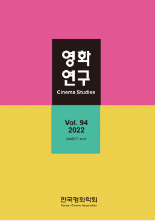- 영문명
- “Transnational Korean” Martial Arts Films Created by (Possible) Foreign Capital: Censorship and Martial Arts Films from 1966 – 1973
- 발행기관
- 한국영화학회
- 저자명
- 송아름
- 간행물 정보
- 『영화연구』제94호, 169~205쪽, 전체 37쪽
- 주제분류
- 예술체육 > 예술일반
- 파일형태
- 발행일자
- 2022.12.31
7,240원
구매일시로부터 72시간 이내에 다운로드 가능합니다.
이 학술논문 정보는 (주)교보문고와 각 발행기관 사이에 저작물 이용 계약이 체결된 것으로, 교보문고를 통해 제공되고 있습니다.

국문 초록
이 글은 1966년에서 1973년, 약 6-7년 사이에 등장한 ‘트랜스 내셔널’하면서도‘한국’영화였던 모순적인 형태의 영화들이 외화(外貨) 획득의 가능성을 포착한 검열과 길항하며 등장하였음을 설명하고자 한다. 1960년대 중반을 넘어서면서 한국에 들어오기 시작한 중국풍 무술영화들은 동남아 일대에서 대대적인 흥행을일으키고 있었고, 이와 유사한 영화들은 곧 수출의 가능성으로 이어지는 것이었다. 영화법에 수출입업 등을 위한 미화(美貨) 실적을 명시할 만큼 외화획득에 적극적이었던 당국은 당시 비판일색이었던 이 영화들과 유사한 합작 그리고 국산영화를 허용하며 외화를 벌 수 있는 가능성에 집중했다. 검열은 당대 무술영화에쏟아지던 비판을 의식하면서도 영화의 내용에는 전혀 영향을 끼치지 못할 절차들로 이를 해결하려 하거나, 외화를 들여오는 조건으로 내건 외국인 출연을 승인하면서 서류상으로만 국산영화인 ‘외화 같은’ 영화들을 허가했고, 의도치 않은‘트랜스 내셔널’ ‘한국’영화는 이렇게 한국영화 내에 자리할 수 있었다. 이렇게본다면 검열은 고정된 제도라기보다 다양한 상황들 속에서 끊임없이 승인 논리를 변화시키며 움직이는 유동적인 현상으로 설명할 수 있을 것이다.
영문 초록
This paper thereby seeks to explain how these films, paradoxically both “transnational” and “Korean,” that appeared within the span of approximately six to seven years between 1966 and 1973, were able to be produced through the “benefits” perceived by the censors. Chinese-style martial arts films, which had entered South Korea after the mid-1960s, were enjoying huge success in Southeast Asia and similar films were able to be made through the possibility of exports. The censors, who were so enthusiastic about procuring foreign capital that they even stipulated a requirement to show records of American dollars earned in order to conduct film imports and exports in the Motion Picture Law, permitted these highly criticized films—both domestic and co-productions—and focused on the possibility of earning foreign capital. Even as the censors recognized the surge of criticism towards martial arts films, they attempted to solve any issues through procedures that were unable to influence the contents of these films and approved films featuring foreign actors which were seen as domestic only in their documents under the condition of verifying the procurement of foreign currency. “Korean” films that unintentionally became “transnational” thus came to find their location within South Korean film. Seen from this perspective, censorship was not a fixed system, but can instead be explained as a flexible phenomenon that endlessly changed their logic of approval and moved from within a diverse array of circumstances.
목차
1. ‘저질 무술영화’에 대한 편견이 덮은 근본적인 질문
2. 법령에 명시된 ‘외화 실적 기준’과 수출 전제의 ‘중국풍’ 허용
3. ‘무의미한’ 절차를 통한 ‘모호한 시공간’의 합법화
4. ‘예약된 외화’가 수용한 ‘외국 배우’ 중심의 국산영화
5. 기대 이하의 성과와 ‘내수용’ 무술영화로의 전환
키워드
해당간행물 수록 논문
참고문헌
관련논문
예술체육 > 예술일반분야 BEST
- 생성형 AI 도구와 디자이너의 협업 프로세스 개발 - 이미지를 통한 아이디어 확산에서 고해상도 렌더링까지
- 영화 [올드보이]와 소포클레스 「오이디푸스 왕」의 상동성 연구
- ‘일과 삶의 균형(Work-Life Balance)’ 척도 개발을 위한 연구
최근 이용한 논문
교보eBook 첫 방문을 환영 합니다!

신규가입 혜택 지급이 완료 되었습니다.
바로 사용 가능한 교보e캐시 1,000원 (유효기간 7일)
지금 바로 교보eBook의 다양한 콘텐츠를 이용해 보세요!



